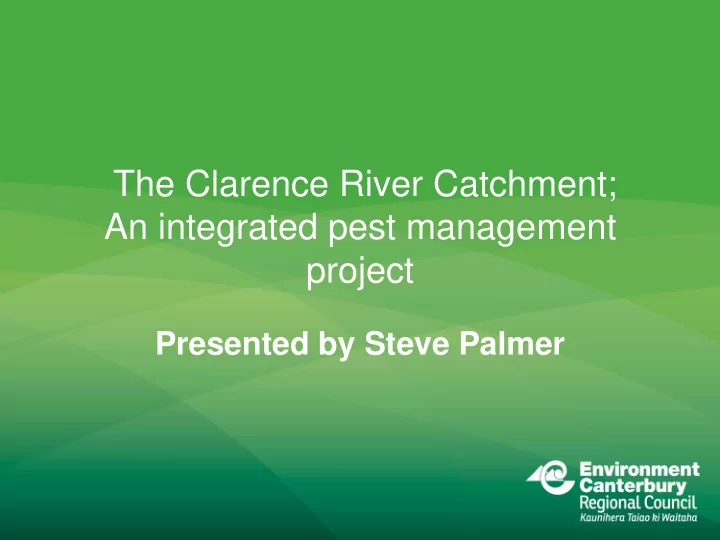

The Clarence River Catchment; An integrated pest management project Presented by Steve Palmer
The Clarence catchment; some random facts. • 3500 square kms in size • The Clarence River runs from Lake Tennyson to the coast w hich is about 230kms • It spans two Territorial Authorities. Environment Canterbury and the Marlborough District Council. • Relatively few landow ners in comparison w ith other catchments of this size • Relatively inaccessible • Home to a variety of threatened plant and animal species. • 90% of the plant pests (excluding w ilding conifers) are located very close to the River itself. • Broom, and to a lesser extent Gorse are the predominant plant pests. (excluding w ilding conifers)
The Project In 2013, the newly formed Kaikoura Zone Committee identified the Clarence catchment as one of their 5 priority sites. The proposal was to plan and implement an integrated pest management strategy for the whole catchment Work didn’t really start until late 2014 by which time we had identified that all the main “players” were already spending large amounts of money on annual programmes themselves. There was however, a level of frustration about the timing and methodology of some control that had occurred in the past. Some “quick wins” were identified. Environment Canterbury and The Kaikoura Zone Committee approved a funding contribution of $78,000. This allowed us to go to the table with the other landowners with something to offer in return for a more structured holistic approach to plant pest control over the entire catchment. The $78,000 was topped up by landowner and other Agency contributions to a point where we had a total budget for Phase 1 of $124,000
. Work begins The Catchment was split into 4 “Areas”. These were based on; • Plant pest density • Territorial Boundaries and Operational considerations such as access etc • Areas 1, 2 and 4 were identified as the “quick win” blocks and control was commenced on Broom, Gorse, Old Mans Beard, Hawthorn, Willow and Cotoneaster. Area 3 however, was a completely different block with large areas of dense Broom spreading away from the River. Most of Area 3 also fell within the Marlborough district which meant we couldn’t spend any of the Environment Canterbury funding in there. The first “Phase” of this co-ordinated control was completed by May 2015
. Work begins
. Soooo…What to do with Area 3 ?? Enter Lynley Hayes from Landcare Research and the Broom Gall Mite. 1. Survey results…Gall mite didn’t appear to be present in the catchment 2. Ministerial approval was required to release a “new” organism onto conservation estate First release on “private land only”, occurred on April 23 rd and 25 th 2015. 3. 4. Ministerial approval to release on conservation estate gained in October 2015 5. Second release occurred in December 2015, mostly on Conservation Estate
. Phase 1 completed by May 2015 • $124,000 spent in total, excluding Molesworth expenditure • 1382 Gall mite infested “twigs” distributed by helicopter over 40kms of riverbed • All landowners and Agencies seem very pleased with the results Phase 2 gets approval in July 2015 A further $60,000 spend approved by the Kaikoura Zone Committee • • This is “topped up” with $89,000 from other landowners or Agencies • Molesworth Station very supportive of the “catchment approach” and already spending significant sums • Ministerial approval to release Gall Mite onto Conservation estate granted in October 2015. This occurs in December 2015. 1800 “twigs” put out by aerial and ground methods. • More traditional control occurs between November 2015 and March 2016 Phase 2 completed by May 2016. •
. Gall Mite summary • In March 2015, we didn’t think the Gall mite was present in the Clarence catchment • First release occurs in April with 1382 twigs dropped Second release occurs in December 2015 and we notice from the helicopter some • heavily infested bushes across the River from where the April release took place • Planned “ground” application by Department of Conservation staff in December is almost a non-event as they find the Gall mite on all the riverflats • During the December 2015 flights, it seemed there was much less flower on the broom in the April 2015 release area than further upstream where no release had occurred??? • Some exact December 2015 release sites were checked in April 2016 with very promising results • Total cost of Phase 1 and 2 Gall mite releases…..$10,300
Recommend
More recommend